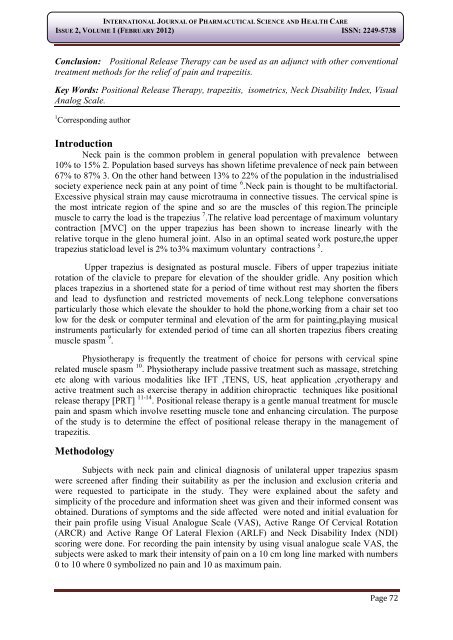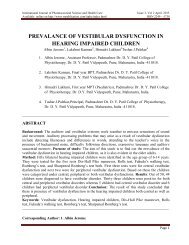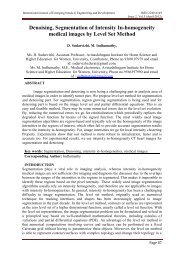Effectiveness Of Positional Release Therapy In Treatment Of Trapezitis
Effectiveness Of Positional Release Therapy In Treatment Of Trapezitis
Effectiveness Of Positional Release Therapy In Treatment Of Trapezitis
Create successful ePaper yourself
Turn your PDF publications into a flip-book with our unique Google optimized e-Paper software.
INTERNATIONAL JOURNAL OF PHARMACUTICAL SCIENCE AND HEALTH CARE<br />
ISSUE 2, VOLUME 1 (FEBRUARY 2012) ISSN: 2249-5738<br />
Conclusion: <strong>Positional</strong> <strong>Release</strong> <strong>Therapy</strong> can be used as an adjunct with other conventional<br />
treatment methods for the relief of pain and trapezitis.<br />
Key Words: <strong>Positional</strong> <strong>Release</strong> <strong>Therapy</strong>, trapezitis, isometrics, Neck Disability <strong>In</strong>dex, Visual<br />
Analog Scale.<br />
1 Corresponding author<br />
<strong>In</strong>troduction<br />
Neck pain is the common problem in general population with prevalence between<br />
10% to 15% 2. Population based surveys has shown lifetime prevalence of neck pain between<br />
67% to 87% 3. On the other hand between 13% to 22% of the population in the industrialised<br />
society experience neck pain at any point of time 6 .Neck pain is thought to be multifactorial.<br />
Excessive physical strain may cause microtrauma in connective tissues. The cervical spine is<br />
the most intricate region of the spine and so are the muscles of this region.The principle<br />
muscle to carry the load is the trapezius 7 .The relative load percentage of maximum voluntary<br />
contraction [MVC] on the upper trapezius has been shown to increase linearly with the<br />
relative torque in the gleno humeral joint. Also in an optimal seated work posture,the upper<br />
trapezius staticload level is 2% to3% maximum voluntary contractions 5 .<br />
Upper trapezius is designated as postural muscle. Fibers of upper trapezius initiate<br />
rotation of the clavicle to prepare for elevation of the shoulder gridle. Any position which<br />
places trapezius in a shortened state for a period of time without rest may shorten the fibers<br />
and lead to dysfunction and restricted movements of neck.Long telephone conversations<br />
particularly those which elevate the shoulder to hold the phone,working from a chair set too<br />
low for the desk or computer terminal and elevation of the arm for painting,playing musical<br />
instruments particularly for extended period of time can all shorten trapezius fibers creating<br />
muscle spasm 9 .<br />
Physiotherapy is frequently the treatment of choice for persons with cervical spine<br />
related muscle spasm 10 . Physiotherapy include passive treatment such as massage, stretching<br />
etc along with various modalities like IFT ,TENS, US, heat application ,cryotherapy and<br />
active treatment such as exercise therapy in addition chiropractic techniques like positional<br />
release therapy [PRT] 11-14 . <strong>Positional</strong> release therapy is a gentle manual treatment for muscle<br />
pain and spasm which involve resetting muscle tone and enhancing circulation. The purpose<br />
of the study is to determine the effect of positional release therapy in the management of<br />
trapezitis.<br />
Methodology<br />
Subjects with neck pain and clinical diagnosis of unilateral upper trapezius spasm<br />
were screened after finding their suitability as per the inclusion and exclusion criteria and<br />
were requested to participate in the study. They were explained about the safety and<br />
simplicity of the procedure and information sheet was given and their informed consent was<br />
obtained. Durations of symptoms and the side affected were noted and initial evaluation for<br />
their pain profile using Visual Analogue Scale (VAS), Active Range <strong>Of</strong> Cervical Rotation<br />
(ARCR) and Active Range <strong>Of</strong> Lateral Flexion (ARLF) and Neck Disability <strong>In</strong>dex (NDI)<br />
scoring were done. For recording the pain intensity by using visual analogue scale VAS, the<br />
subjects were asked to mark their intensity of pain on a 10 cm long line marked with numbers<br />
0 to 10 where 0 symbolized no pain and 10 as maximum pain.<br />
Page 72





